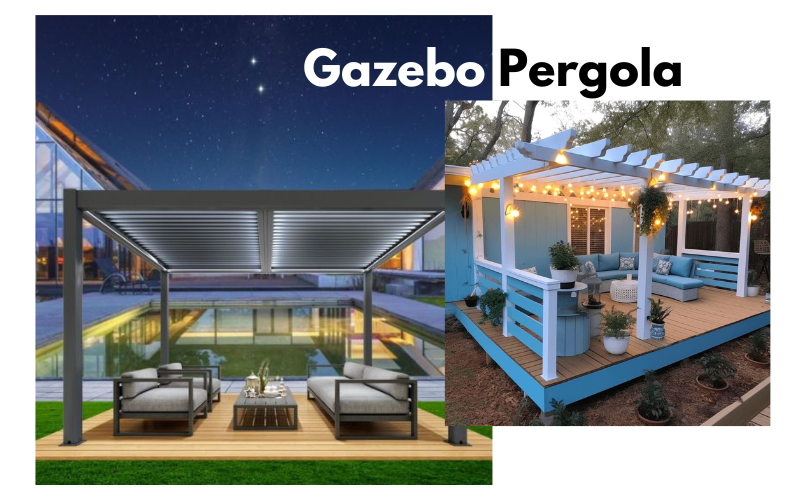When designing an outdoor space, one common decision homeowners face is whether to choose a gazebo or a pergola. Both structures can enhance the aesthetic and functionality of your backyard or garden, but they have distinct differences in terms of design, purpose, and utility. Understanding these differences is essential for selecting the right option for your outdoor area. In this guide, we will break down the key differences between a gazebo and a pergola, examining their features, uses, materials, and other factors that may influence your decision.
Introduction to Pergolas and Gazebos
Before diving into the specifics, it’s important to understand what each structure is and its typical purpose.
What is a Pergola?
A pergola is an outdoor structure composed of vertical posts or columns supporting an open roof of beams and rafters. Typically, pergolas provide partial shade, but their open design allows sunlight to filter through. Pergolas are often used to define outdoor spaces, create shaded walkways, or serve as a support structure for climbing plants.
- Common Uses:
- Defining an outdoor seating area or garden.
- Providing a decorative feature with partial shade.
- Creating a support for climbing plants like wisteria or vines.
What is a Gazebo?

A gazebo is a freestanding, often octagonal or circular structure with a fully covered roof that provides complete shade and shelter from the elements. Gazebos are more enclosed than pergolas and are commonly used as standalone structures in gardens, parks, or patios.
- Common Uses:
- A focal point in gardens or outdoor settings.
- Providing full shelter from sun and rain.
- Creating an intimate space for outdoor dining or relaxation.
Key Design Differences Between Gazebos and Pergolas

1. Roof Structure and Coverage
One of the primary differences between a gazebo and a pergola is the roof.
- Pergola Roof: Pergolas feature an open-roof design. The roof is made of crossbeams and rafters that may support climbing plants or a retractable canopy, but they do not provide full protection from rain or intense sunlight. This allows for natural light to pass through, making the space feel airy and open.
- Actionable Tip: If you want more protection from the elements while maintaining the open feel of a pergola, consider adding a retractable canopy or shade cloth to the roof structure.
- Gazebo Roof: Gazebos have a solid roof that fully protects from rain, sun, and other weather conditions. The roof is often pitched and can come in various materials, such as wood, shingles, or metal, providing a more traditional or rustic look.
- Actionable Tip: A gazebo is the better option if you need a sheltered outdoor space where you can enjoy the outdoors in any weather.
2. Structure and Shape
- Pergola Structure: Pergolas typically have a rectangular or square layout, supported by four columns or posts. The design is simple yet elegant, with a focus on open spaces and a more minimalist aesthetic.
- Gazebo Structure: Gazebos, on the other hand, are often more intricate in design and come in various shapes, most commonly octagonal or round. Some gazebos may also have built-in seating, railings, or latticework around the sides, creating a more enclosed feel compared to pergolas.
3. Level of Shelter and Shade
The primary difference between these two structures is the level of shade and shelter they provide.
- Pergola Shade: Pergolas provide partial shade, and they are perfect for creating an outdoor space that feels open yet still offers some protection from the sun. If you prefer a bit of sunlight and want to maintain a sense of openness, a pergola is an excellent choice.
- Gazebo Shelter: With its fully enclosed roof, a gazebo provides complete shelter from the sun and rain. It’s a great choice if you want a more private, covered space that can be used year-round, even in bad weather.
Table: Comparison of Pergolas and Gazebos
| Feature | Pergola | Gazebo |
|---|---|---|
| Roof Type | Open, beams and rafters | Fully enclosed, solid roof |
| Shade Level | Partial shade, open feel | Full shade, weather protection |
| Structure Shape | Rectangular or square | Circular, octagonal, or rectangular |
| Use of Space | Open, airy spaces | Private, enclosed spaces |
| Climbing Plants | Great for supporting plants | Not designed for climbing plants |
Materials and Durability: Gazebos vs. Pergolas
Both gazebos and pergolas can be constructed from a variety of materials, but there are differences in the materials typically used for each structure and their durability.
Materials for Pergolas
- Wood: The most common material for pergolas is wood, especially cedar, redwood, or pressure-treated pine. Wood pergolas offer a classic, natural look, but they require regular maintenance to prevent rot, insect damage, or warping.
- Vinyl: For a low-maintenance option, vinyl pergolas are increasingly popular. They provide the same aesthetic appeal but require little to no upkeep.
- Metal: Pergolas made of aluminum or steel are modern and sleek. They offer durability and resistance to rust, making them a good option for areas prone to rain.
Materials for Gazebos
- Wood: Wooden gazebos are traditional and create a rustic, elegant feel. Cedar and pine are common choices, but as with pergolas, wood gazebos require maintenance.
- Metal: Metal gazebos, typically made from steel or wrought iron, are durable and provide a more contemporary look. These structures are designed to withstand harsh weather.
- Vinyl: Vinyl gazebos are also available for those who prefer a low-maintenance structure that can endure exposure to the elements without frequent repairs.
Pergola vs. Gazebo: Best Uses Based on Outdoor Needs
1. Pergola Uses
- Enhancing Gardens: Pergolas are often used to enhance gardens or patios, creating an elegant space that blends into the landscape. With climbing plants, such as roses or ivy, a pergola can become a living structure, making your garden even more inviting.
- Defining Outdoor Spaces: If you have an open backyard or a large patio, a pergola can help define the space without blocking views or creating a closed-off area.
- Partial Shade and Outdoor Dining: Pergolas work well as a light shade for outdoor dining areas. You can add lighting, vines, and hanging plants to enhance the dining experience.
2. Gazebo Uses
- Shelter from the Elements: Gazebos are ideal for people who want a fully covered outdoor space. They are perfect for hosting outdoor gatherings, rain or shine, and provide a comfortable retreat from the elements.
- Creating Intimate Spaces: The enclosed design of a gazebo offers more privacy, making it the perfect place for an outdoor hot tub, intimate gatherings, or a peaceful reading nook.
- Year-Round Use: Because of the full coverage, a gazebo can be used year-round, even in harsher weather conditions, unlike a pergola, which is more suited for fair-weather use.
Customization and Additional Features
Both pergolas and gazebos offer a variety of customization options to suit your personal preferences and landscape.
Pergola Customization
- Climbing Plants: Add greenery by growing climbing plants like wisteria, grapevines, or clematis along the structure.
- Lighting: Hang string lights or lanterns from the beams for evening use, creating a romantic, ambient atmosphere.
- Shade Solutions: For added versatility, consider a retractable canopy or weather-resistant fabric to provide more shade when needed.
Gazebo Customization
- Screens or Curtains: To enhance privacy or provide extra protection from bugs, you can add screens or curtains to the sides of the gazebo.
- Flooring Options: Gazebos often feature raised flooring, which can be constructed from wood, stone, or even composite materials for durability and aesthetics.
- Integrated Seating: Many gazebos come with built-in seating, adding comfort and functionality to the space.
Which is Right for You: Pergola or Gazebo?
When deciding between a pergola and a gazebo, consider the following:
- Climate and Weather: If you live in an area that experiences heavy rain or intense sun, a gazebo with a solid roof may offer more protection. In contrast, a pergola is more suited for areas where you want light filtering shade and an open feel.
- Intended Use: Think about how you plan to use the structure. A gazebo offers more privacy and can be used year-round, while a pergola is great for creating a focal point in your garden or an airy outdoor dining area.
- Aesthetic Preferences: Gazebos tend to be more traditional and enclosed, while pergolas have a modern, open look. Choose the one that fits the overall aesthetic of your home and landscape.
Conclusion
Both pergolas and gazebos offer unique benefits for outdoor living spaces. A pergola provides partial shade and an open feel, making it a great choice for patios, walkways, and garden features. Meanwhile, a gazebo offers full shelter and privacy, making it ideal for year-round use and more intimate settings. By considering your needs,


